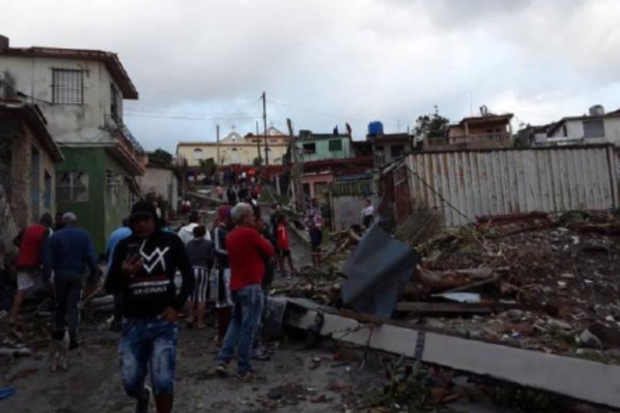
By Leni Villagomez Reeves
In Comunidad Castanedo, Elsida Martinez described surviving the tornado that hit her Guanabacoa home on the night of Jan. 27. “It sounded like a hundred airplanes or trains coming at you,” she said. Boards from her wall fell at a slant held up by an armchair; she sheltered under these holding her granddaughter in her arms.
Immediately after the disaster, “the government” was there, she said, referring to her local municipal representative Maria Margarita Estrada, among others. They helped set up emergency shelter.
There were many victims of the tornado that tore through parts of La Habana del Este, Guanabacoa, Regla, San Miguel del Padrón and Diez de Octubre (districts of Havana) killing seven, injuring more than 195 and damaging more than 3,500 dwellings along with hospitals, schools and other infrastructure. Cuba is used to hurricanes, which are more predictable and slower, but had never had a EF4 tornado hit a city before.
Cuba has a disaster response that is both governmental and organized, and volunteer and spontaneous, called forth by a spirit of national pride and solidarity, as well as simplehuman compassion. By dawn, Cuban President Miguel Diaz-Canel was on the scene.
By Feb. 23, less than one month post-tornado, in this area of Guanabacoa, 804 new dwellings had been constructed and turned over to residents who lost their homes. The hospital was up and running. All electricity had been restored. Cubans from all over the island came to work on repair, aid and reconstruction. Volunteers collected clothing and household goods.
Reconstruction didn’t stop. In June, about five months post-disaster, when members of the Pastors for Peace Caravan to Cuba talked to Martinez in her new home, she said that everything in her place (e.g., stove, refrigerator, table, chairs, TV, bed) had been given to her by the government “except the electric fan, which was donated by a church.”
Maria de los Angeles Vargas told a harrowing story of her survival. She was in the house with her adult daughter, who had just been released from hospital after surgery for thyroid cancer. The roof was torn away, but they sheltered under the bed. She had a heart attack brought on by the stress and was taken to a hospital, still worrying about her daughter, who was also taken to a medical facility for care.
Vargas is in a new home, with mostly new possessions, though the bed (“the mattress is still drying”) and some clothing, especially her shirt with the Virgin Mary, are still with her. She and her daughter are doing well.
As we see everywhere in times of disaster, most people naturally want to help. In a system that abandons poor people to their own bad luck in disaster, we have Katrina, where the Red Cross and FEMA (Federal Emergency Management Agency) fake it and victims are abandoned, even while people are contributing money and trying to volunteer—but that goes nowhere.
When there is a system in place that not only enables helpfulness but also, more important, takes direct responsibility for restoring people to a livable situation, things go better.
*****
Leni Villagomez Reeves is a local physician and activist. Contact her at lenivreeves@gmail.com.
